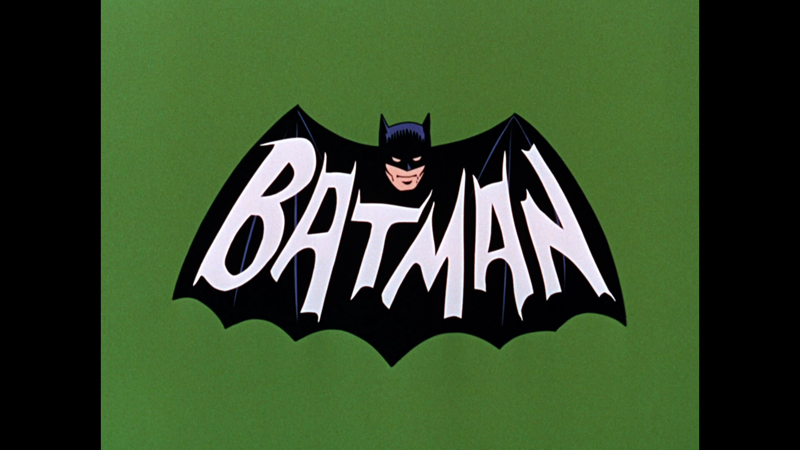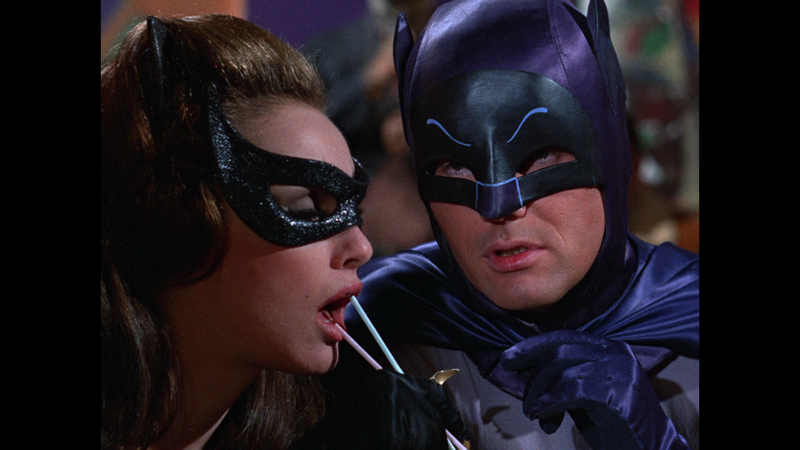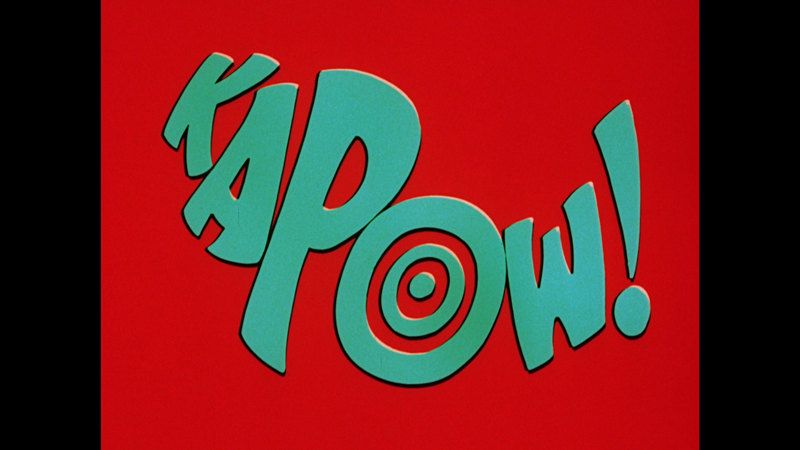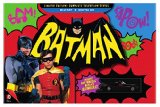| Reviews & Columns |
|
Reviews DVD TV on DVD Blu-ray 4K UHD International DVDs In Theaters Reviews by Studio Video Games Features Collector Series DVDs Easter Egg Database Interviews DVD Talk Radio Feature Articles Columns Anime Talk DVD Savant Horror DVDs The M.O.D. Squad Art House HD Talk Silent DVD
|
DVD Talk Forum |
|
|
| Resources |
|
DVD Price Search Customer Service #'s RCE Info Links |
|
Columns
|
|
|
Batman The Complete TV Series Limited Edition Blu-ray
The most fun Batman finally comes home

Loves: The ‘60s Batman series
Likes: Batman in general, the core villains on the show
Dislikes: King Tut
Hates: Collectible pack-ins
The Show
Not too long ago, I spent more time than I like to think about recording all the episodes of the 1960s Batman series from television. I figured, there's no chance I'm ever going to get authorized copies of these shows, and I'm not about to pay the outrageous prices charged for bootleg copies at comic conventions. I should have known though, as I recorded and archived the last one, that an announcement of new DVDs and Blu-rays would be made. So if you were looking forward to this release, you have me and the hours I spent recording and cutting out commercial breaks to thank for its existence.
It's really a testament to awful business that it's taken this long for this set to be willed into existence. If Warner Brothers and FOX were smarter, they easily could have sold people three or four separate sets of the show by this point. Heck, if they would have jumped on the bandwagon at the time when A&E was charging $30 for four episodes of The Prisoner or Monty Python's Flying Circus, the money the companies could have made would be astronomical. Well, at least they are finally here, so fans who grew up with these oft-silly adventures can tune in at any Bat-time they please.
Speaking of those adventures, this is the show that set the tone for the Batman franchise for decades, good and bad, as its indelible mark is hard to erase. The power of the show is in how iconic it was, with every element so vibrant that it's impossible to forget. Yes, it had the advantage of being the first modern-era mass-media representation of the character, and it also basically had the stage to itself forever, but there was so many memorable ingredients that made it the definitive Batman for generations. First among those were the performances of Adam West as Batman and Burt Ward as Robin. Playing it completely straight--West with thoughtful gravitas, Ward with youthful enthusiasm--these actors kept the show from descending into parody. The world may be crazy, but our heroes remain vigilant defenders and detectives. The contrast makes their square-jawed heroics comedic, and the effect is enhanced when things get unusual like seeing Batman dance or surf, or when the Dynamic Duo are chilling out in the Batmobile eating burgers.

The structure of the series, which leans heavily on the style of the old serials and a well-defined formula, was also a big reason for the show's success and long-lasting legacy. During the first two seasons, stories were split over two half-hour episodes, shown twice a week. The first episode would always end with Batman and Robin on the edge of destruction in some sort of insane death-dealing set-up, with the now classic refrain "same Bat-time, same Bat-channel" reminding viewers to come back to see the story's weekly conclusion. These cliffhangers, along with the emphatic narration, the atmospheric music, the wonderfully detailed sets and costumes and the choreographed fight scenes, which feature the show's famous "Pow!" and "Bam" visual sound effects, all serve to create a larger-than-life adventure series that's great fun to watch.
Though West doesn't appreciate the show being described as campy, it's hard to think of a word that fits the series better. The thing is, you have to separate the ideas of bad and camp. Camp doesn't have to be bad. It just has to be absurdly silly. So much of the show is obviously aiming for comedy, be it the way Batman solves impossible clues impossibly quick, the goofy names of the bad guys' labeled henchmen, the villains' strange obsession with personal branding, the overly literal signs seen all over the place, or the strangely specific gadgets Batman always has at the ready. I mean, really...an empty alphabet soup bat-container? Then there are the overtly humorous parts, like the cameos when Batman and Robin climb up the sides of buildings, which feature celebrity cameos from Sammy Davis Jr., Don Ho, Santa Claus and Lurch from The Addams Family. Elements like this earn plenty of chuckles throughout the series, but they don't take away from the fun of the action or the crime-fighting plots. They also serve to make for what might be the most accessible Batman ever; enjoyable for young and old alike.
The show burned brightly, but only for three seasons, crashing hard considering the show's immense popularity. Perhaps it was overexposure due to the twice-a-week schedule, with 58 episodes in season two, but the show was definitely showing signs of slowing down in the final season before cancellation, including mostly eliminating the cliffhanger, instead linking episodes via a coda at the end. Whether it was an artistic choice or otherwise, the weird way the show started to use "suggested sets," in which parts of a set were placed in an otherwise black room to create the idea of the setting, made it seem like something had changed for the worse. Another major change in the third season also stood out somewhat negatively, as Yvonne Craig's Batgirl (the crime-fighting alter-ego of police commissioner Gordon's daughter Barbara) was added to the show as a regular. She didn't bring a great deal to the party though, outside of a great costume design, as she often needed saving as much as she helped the team.
The other issue with Batgirl was she was further evidence of the show being a product of its time, as, in addition to the clothes, sets and language all being heavily dated to the ‘60s (especially in the third run), sexism is rampant throughout the series, whether display via the eye-candy molls of the villains or the drooling narration for the new distaff member of the Bat-team. The portrayal of women is pretty much entirely negative in the show, with flippant remarks about the vanity of women or their value, while one villain, Nora Clavicle, is actually a women's rights activist, who replaces the police force with women, who are only interested in coupons and recipes. The rampant misogyny is odd considering the show was progressive enough to have an interracial flirtation between West's Batman and Kitt's Catwoman.
Though the Caped Crusader and the Boy Wonder are obviously the stars of the show, the villains are what defines the series, as has always been the case with Batman. In addition to his traditional rogues gallery, including Joker, Riddler, Penguin and Catwoman, this series introduced a number of freshly-minted felons, some of which eventually were incorporated into the comic books, like Victor Buono's over-acted King Tut. The oft-ridiculous nature of these baddies, which were often created to give big celebrities of the day a chance to play, like Zsa Zsa Gabor's Minerva, Milton Berle's Louie the Lilac or Liberace's Fingers, was a big part of why the show was viewed as campy.
As goofy as the new creation were, the originals were wonderfully evil, especially Cesar Romero's Joker, Frank Gorshin's Riddler and Julie Newmar's Catwoman (though that shouldn't take anything away from Eartha Kitt's purr-fect turn in the cat suit in the show's third season.) These three each brought something special to the show, be it Romero's manic glee, Gorshin's dark intensity or Newmar's unrestrained sensuality. The problem with having the villains be such a focal point of the show is it makes the series uneven, as a weak villain, like Van Johnson's Minstrel or Maurice Evans' Puzzler, usually makes for a weak episode. The exception to that rule would have to the two-part "A Piece of the Action"/"Batman's Satisfaction", which had a terrible nemesis in the stamp-forging Colonel Gumm, but which is great fun because of a crossover with The Green Hornet, which meant Van Williams and Bruce Lee were on hand for twice the crime-fighting action. Just seeing Lee on Batman was great, but having two masked heroes and their rich alter-egos interacting without each other knowing made for a fun twist on the heroes.
Note: There seems to be a scene missing in the episode "Marsha's Scheme of Diamonds," as the traditional gag scene just before the credits is missing, though a promo for an upcoming episode is still there. This episode has only five chapters to it, unlike the others, which have six.

The Discs
This release arrives in a truly impressive limited-edition package, which is individually numbered out of 95,000 pieces. The 13-disc set is packed into three digipak folders (one per season) with the larger second season packed in overlapped dual-hubbed trays. These folders are packed, with the sets pack-in items, in a large die-cut box that seals with a magnet closure. On the side of the box is a button that, when pressed, plays a clip of the Batman theme. The only minor negative was the fact that the inside of the front panel, which helps keep everything in place, fell off when the box was first opened (apparently the glue used gave way.) Disappointingly, these discs feature Warner Brothers' bland static menu system, which offers a choice to play all episodes, select shows and adjust the set-up. Audio options include Dolby Digital 1.0 English, French, German and Italian (though several episodes lack the Italian, and the entire third season lacks French tracks), while subtitles are available in English SDH, French, Spanish, Italian and German. To see more about the package, check out the video below.
The Quality
Considering that all we've ever seen of this Batman before was old broadcast versions, syndicated airings and awful, overcompressed bootleg releases, these pillarboxed 1080p, AVC-encoded transfers are like seeing the series for the first time. Shot on film with an eye toward candy-colored pop art, the series looks tremendous, with bright, vivid color, consistent grain and a level of detail the show has never revealed before. The sparkle of the costumes on Batgirl and Catwoman's costumes, the folds of fabric in Batman's cape, the intricate design of the villains' lairs (at least in the first two seasons), the opening animation, and the bright yellow credits and titles--it all pops to life in a way it never has before. Now, it's not perfect, but the vast majority of the issues can be attributed to the source material, like the (possibly stock) establishing shots used repeatedly, showing some excessive noise, or some infrequent consistency concerns as far as the sharpness goes (some of which is the result of obvious soft focusing on a few of the female guest stars.) However the show is essentially free of any problems with dirt or damage, and there were no obvious issues with digital distractions.
The Dolby Digital 1.0 tracks are simple, appropriate and sufficiently strong for this series. The show's signature music is clear and well-defined, while the dialogue is crisp and consistently legible. The sound effects, which are a big part of the feel, are similarly good. Unlike with modern bombastic multi-channel audio, it's really in the little things that the quality of this presentation shines through, like in the clarity of the horns that score each fight scene,
The Extras
Looking at the set as a whole, it's easy to wonder why the first 12 discs are extras-free. There's not a commentary to be found. Considering how long the wait has been, and how influential and popular the show is, you'd think there would be plenty of people that would want to sit down and talk about this show. It's bad enough that the lengthy delays have resulted in many of the cast and creators passing before its release, but to not have any contemporary perspectives is just doubling down on this problem.
There's also the fact that two separate releases of bonus content that have been released in the past, "Holy Batmania!," which offered four documentaries on the series, and "Adam West Naked," a collection of recollections produced by West himself. Some of this contest should have been included on the third disc of season three, which has just two 30 minute episodes. What's worse is Warner Brothers is offering "Adam West Naked" as part of an odd package online that includes the first 64 episodes, the Batman ‘60s movie and some ephemera. Why offer this content in that collection, but not with this higher-priced set.
Thankfully the 13th disc fills in a lot of the gaps holding all of the set's bonus content, most of which is courtesy of master extra maker Alexander Gray, who has produced and directed this kind of material for loads of DC-related DVDs. It all starts with "Hanging with Batman" (29:56), which focuses on West, looking at his life, from his childhood to his acting career, with plenty of time on his experiences as Batman and the legacy of that performance. The piece, which is loaded with archival photos and video, isn't fluffy in any way, touching on some of the darker moments of West's life, including controversy that surrounded him at his peak as a star and his personal and professional struggles in the wake of the show's cancellation and the character's rebirth with the Tim Burton movies. An excellent profile of a charismatic man with an interesting life.
"Holy Memorabilia, Batman!" (29:59) looks at the fans, a few in particular, and the collecting that sprung up around the show, including the key pieces and the process of acquiring them. With Toy Hunter's Jordan Hembrough providing expert (and some personal) perspective, the featurette checks out the collections of actor Ralph Garman (Family Guy, the Hollywood Babble-On podcast) and Guinness record-holder Kevin Silva, as well as the work of Mark Racop, who builds replica Batmobiles. The Garman segments also feature a visit by West to check out (and even try on) the goods, and the result is an excellent look at a side product of the series.
An odd inclusion is "Na Na Na Batman" (12:15) which features a huge roster of producers and directors from Warner Brothers-produced series talking about the Batman series, including their memories of watching the show (if they are old enough) along with the costumes and villains. The connection to the show for most of these participants, which include Kevin Bacon, James Purefoy, Mike O'Malley, Stephen Amell, Jared Padalecki, Misha Collins and Jensen Ackles, is beyond tangential, which coats the whole piece with a sheen of promotion, but if you're a fan of shows like Supernatural, Arrow, The Following and The Mentalist, perhaps you'll enjoy these worlds crashing together. Wedged in here with all these people is West and Burt Ward, bringing things back to center a bit.
The point of "Batmania Born!" (29:41) isn't entirely clear, as it can get a bit scattered in terms of the subject matter, but it seems to mainly talk about the look of the series, and mainly features the voices of people from the world of comic books and related TV series, though some production design and costuming people sneak in as well to discuss the visuals of Batman, including the influences of the comic books, the animated opening, the tights and, most interestingly, the negative effect the show had on comic books in the larger world of entertainment. Among those sitting down to chat are Jim Lee, Bruce Timm and Julie Newmar, long with archival clips of Cesar Romero and Frank Gorshin, making this catnip for comics fans.
Lee and Garman return in "Bats of the Round Table" (45:08), joining Batman superfan Kevin Smith and actor Phil Morris (Smallville), as they sit down for a meal with West. Unsurprisingly, the chat is dominated by Smith--a natural conversationalist--but they all chime in at some point, peppering West with questions and actually getting some interesting answers, including talk about dealing with a difficult Otto Preminger, who West's favorite guest star and favorite Catwoman was, life on the set and a fun story about Ward and Bruce Lee. One wonders how the mostly unconnected Morris got in on this group (though he does have a Batman story of his own to share), but they all interact well in a smooth-flowing get-together. The ending may be slightly cheesy, but it's a satisfying featurette.
Though there are no commentaries in this set, there are two pseudo-commentaries, in the form of the two-part "Inventing Batman: In the Words of Adam West." These pieces, which run a total of 59:08, feature West, in occasional picture-in-picture appearances, reading excerpts from his shooting scripts for "Hi Diddle Riddle" and "Stuck in the Middle" while the episodes play. There's a tremendous amount of dead air (probably more than half the episodes are just the original audio), which may explain the lack of commentaries, but it's great when West shares the notes he made on the script during the production process and his thought process for the character.
The bonuses wrap up with a quartet of rarities, which are mostly great to check out. First up is the 7:54 pilot for Batgirl. This never-aired "episode" was intended to show the character could work, in advance of her introduction in Batman's third season. This compact adventure, which features Batgirl fighting Killer Moth and his gang alongside the Dynamic Duo in a library, feels just like the Batman series, complete with the "Pow!"s, but with a lot more sexism, courtesy of the narrator and Batman himself. Today, it's really kind of creepy.
Also included are a pair of screen tests for the show, which are truly fascinating. First up is West and Ward (6:16), in a proto-Wayne Manor and the Batcave, doing a pair of scenes, following by a brief tumbling and karate demonstration by Ward and some silent footage of the pair in the ‘Cave. The performances were so fully formed right off the bat (no pun intended) that it's hard to imagine anyone else in the roles. That's solidified when you see Lyle Waggoner and Peter Deyell try out for the parts (4:23), doing the same roles on the same sets, with the same sketchy costumes. Robin is more childish in Deyell's performance, while Waggoner doesn't bring the same measured intensity as West. Watching it though, allows you to picture an entirely different history for Batman.
The final entry is a James Blakely Tribute (2:24). The title is a bit misleading, as it's just a clip of Blakely, post-production supervisor on the show, discussing the story of the series' development and the idea of editing in the show's iconic sound-effects graphics. It's not really a tribute in the traditional manner.
In addition to the on-disc content, the box has several bonus pack-ins, starting with an impressive Hot Wheels Batmobile. A bit longer than your average Hot Wheels car, it's the version from the second series of Batman vehicle, which includes a trailer hitch (for towing the Batboat.) Overall, it looks very nice, though the pipes behind the cockpit are straight instead of slanted, and the overhead handle between the seats, the emergency bat-turn lever, is missing. One nice detail though is the acetate box it arrives in, which has an image of the Batcave along its back wall.
In addition, there's a set of 44 replica trading cards, reproducing a 1966 set from Topps, which is in a cardboard box that's slightly thicker than a standard deck of playing cards. The cards are printed on old-school cardboard and feature illustrations of various scenes with the Dynamic Duo. Unfortunately, the backs of the ‘66 cards have not been included, so all 44 have the same generic Batman logo and legal copy. Also, the original set had 55 cards. What happened with the missing 11 cards is unknown.
Beyond that, there's a 34-page, softcover episode guide, about the height and width of a DVD case, with a short letter from West, as well as disc breakdowns, episode details (including airdate and synopsis), bonus content information and quotes and trivia about the series, along with the 38-page hardcover The Adam West Scrapbook, the same size as the guide, which has lots of great archival photos of West, along with several quotes.
Also in the box is a code to stream or download the series via Ultraviolet.

The Bottom Line
It's only natural that waiting so long for these episodes to arrive on home video has made expectations unmeetable, but between the wonderfully silly show, the quality of the presentation and the excellent extras that actually have been included, this set is one all Batman fans will want to own. However, the limited version has a lot of ephemera that most viewers won't need, and there are many extras out there not available here. If you're patient, perhaps the individual seasons will one day come out on Blu-ray, or even just in a stripped down complete set. Until then. this set is a must-own if money is no object.
Francis Rizzo III is a native Long Islander, where he works in academia. In his spare time, he enjoys watching hockey, writing and spending time with his wife, daughter and puppy.Follow him on Twitter
*The Reviewer's Bias section is an attempt to help readers use the review to its best effect. By knowing where the reviewer's biases lie on the film's subject matter, one can read the review with the right mindset.
|
| Popular Reviews |
| Sponsored Links |
|
|
| Sponsored Links |
|
|
| Release List | Reviews | Shop | Newsletter | Forum | DVD Giveaways | Blu-Ray | Advertise |
|
Copyright 2024 DVDTalk.com All Rights Reserved. Legal Info, Privacy Policy, Terms of Use,
Manage Preferences,
Your Privacy Choices | |||||||













